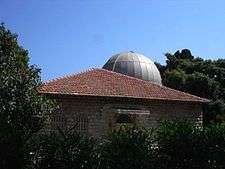Lee Observatory
 | |||||||||
| Organization | American University of Beirut | ||||||||
|---|---|---|---|---|---|---|---|---|---|
| Location | Beirut, Lebanon | ||||||||
| Coordinates | 33°54′1.96″N 35°28′47.29″E / 33.9005444°N 35.4798028°ECoordinates: 33°54′1.96″N 35°28′47.29″E / 33.9005444°N 35.4798028°E | ||||||||
| Altitude | 38 m (125 ft) | ||||||||
| Website | |||||||||
| Telescopes | |||||||||
| |||||||||
 Location of Lee Observatory | |||||||||
The Lee Observatory is a (now closed) astronomical observatory it was the first and the oldest of the Middle East in modern times. It is located in the campus of the American University of Beirut in Beirut, Lebanon.
History
The Lee observatory of the American University of Beirut, opened in 1873. Dr. Cornelius Van Dyck was its pioneer. The observatory was named the 'Lee' Observatory in reference to Henry Lee, a wealthy British merchant from Manchester, who made a significant donation to help finance its construction.
The Observatory had a twin role, sky gazing and a meteorological station for the middle east. Several directors and assistants managed the Observatory, among them:
Dr Van Dyck who had astronomy as a hobby bought most of the equipment from his own budget. Professor Mansour Jurdak and Professor Owen Gingerich with their concept of "Open Nights Observatory" made contributions to the Observatory library.
Saad Sami Haddad drew a sky map of stars up to and including the 5th magnitude. He contributed in the filing of sunspot data taken daily and forwarded them to Zurich, the International center for sunspot research. He made statistical tests revealing the significance of the East-West asymmetry of the sunspots activity. He was also responsible for the gathering of meteorological data.
Today
Nowadays the observatory has only an academic role.
External links
- AUB's detailed history of the Lee Observatory
- A virtual view of the Lee Observatory
- Saad Sami HADDAD alumni article on the Lee Observatory